|
"Mike Mignola interview"
JUN 2001 Product
Click
on graphics to view a larger version.
|
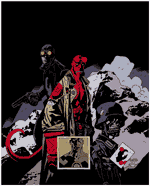 In his career in comics,
Mike Mignola has worked on such diverse projects as DCís Cosmic
Odyssey, Marvelís Incredible
Hulk, and Topps Comics
adaptation of Francis Ford Coppolaís Dracula movie. However, he is best known for his creator-owned character Hellboy,
currently published by Dark Horse Maverick. Worlds of Westfield Content Editor Roger Ash recently spoke with Mignola
about the new Hellboy mini-series, Conqueror Worm. In his career in comics,
Mike Mignola has worked on such diverse projects as DCís Cosmic
Odyssey, Marvelís Incredible
Hulk, and Topps Comics
adaptation of Francis Ford Coppolaís Dracula movie. However, he is best known for his creator-owned character Hellboy,
currently published by Dark Horse Maverick. Worlds of Westfield Content Editor Roger Ash recently spoke with Mignola
about the new Hellboy mini-series, Conqueror Worm.
|
Westfield:
For those unfamiliar with Hellboy, how would you describe the book?
Mike
Mignola: Itís a supernatural, mystery, action thing.
Westfield:
Who is Hellboy and who are some of his supporting cast?
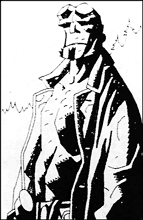 Mignola:
Hellboy is theoretically the worldís greatest occult detective. Heís
actually sort of a demon who was brought to earth at the end of World
War II, raised among humans, thinks of himself pretty much as a human,
but he may actually be the Beast of the Apocalypse. Despite that, heís
a good guy and he fights monsters. The bookís full of other bizarre,
inhuman monster kind of guys who are mostly good guys, a couple humans
sprinkled here and there, Nazi mad scientists, and as many pulp cliches
as I can possibly toss in there. Mignola:
Hellboy is theoretically the worldís greatest occult detective. Heís
actually sort of a demon who was brought to earth at the end of World
War II, raised among humans, thinks of himself pretty much as a human,
but he may actually be the Beast of the Apocalypse. Despite that, heís
a good guy and he fights monsters. The bookís full of other bizarre,
inhuman monster kind of guys who are mostly good guys, a couple humans
sprinkled here and there, Nazi mad scientists, and as many pulp cliches
as I can possibly toss in there.
Westfield:
Do people need to be familiar with past Hellboy stories to enjoy the new
mini-series?
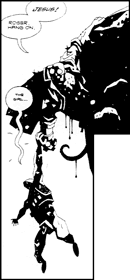 Mignola:
No. This one is self-contained. Iím assuming a previous knowledge of
Hellboy. Given the way the trade paperbacks sells, I assume that means
people are going back and picking up the old stuff. This is very much a
continuation of stuff that has gone on before, but itís a
self-contained story. You can read it and get the whole story, but
youíll get more out of it if youíre familiar with the older stuff. Mignola:
No. This one is self-contained. Iím assuming a previous knowledge of
Hellboy. Given the way the trade paperbacks sells, I assume that means
people are going back and picking up the old stuff. This is very much a
continuation of stuff that has gone on before, but itís a
self-contained story. You can read it and get the whole story, but
youíll get more out of it if youíre familiar with the older stuff.
Westfield:
What can you tell us about the Conqueror Worm mini-series?
Mignola:
Iím two pages short of being done. Thatís good. Hellboy teams up
with Roger the Homunculus to go to the top of a mountain to investigate
a place where the Nazis were working on their space program. This
previously unknown program involved shooting a guy into space and now
that space capsule is returning to earth with dire consequences. And
then all hell breaks loose.
Westfield:
This story seems less supernatural and more odd science-like than
previous stories. Was that intentional?
Mignola:
Not really intentional. Very little in Hellboy is intentional. This one
is actually not based on folklore at all. This is very much a mad
scientist kind of a thing. Certainly, a lot of the short Hellboy stories
are based directly on old folktales or folklore or mythology. The bigger
mini-series tend to be kind of a hodge-podge of stuff, and this is
definitely one of those. There is a lot of supernatural stuff in it.
Itís full of ghosts and that kind of thing, but itís a bit more mad
scientist, alien creature kind of thing.
Westfield:
Nazis figure big as villains in Hellboy. Why is that?
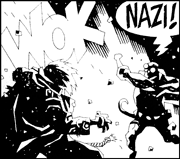 Mignola:
My pat answer for that is that theyíre so easy to use as villains
because they donít require any explanation. There are so many theories
about what the Nazis were up to, you can pretty much say, ďyes, the
Nazis had a space programĒ and people go ďwell that could have been
true. God knows they were working on everything else.Ē Hellboyís
origin ties in with Nazis, itís been an easy thing to go back to, but
I believe this is my last use of Nazis. Theyíre the direct bad guys in
this one, which hasnít really been the case in other mini-series. They
are the main focus of this one, and then when this oneís over, I think
weíre pretty much done. Weíll move on to other bad guys. Mignola:
My pat answer for that is that theyíre so easy to use as villains
because they donít require any explanation. There are so many theories
about what the Nazis were up to, you can pretty much say, ďyes, the
Nazis had a space programĒ and people go ďwell that could have been
true. God knows they were working on everything else.Ē Hellboyís
origin ties in with Nazis, itís been an easy thing to go back to, but
I believe this is my last use of Nazis. Theyíre the direct bad guys in
this one, which hasnít really been the case in other mini-series. They
are the main focus of this one, and then when this oneís over, I think
weíre pretty much done. Weíll move on to other bad guys.
Westfield:
How much research do you do for the various demons and monsters and such
that pop up in Hellboy?
Mignola:
On this one, I did pretty much none other than re-reading the Conqueror Worm poem by
Edgar Allan Poe. This one was pretty much just coming up with stuff off
the top of my head.
Westfield:
How much research do you do in general for Hellboy?
Mignola:
I do a lot. Again, it depends. Certain stories that Iíve done are
directly adapted from folktales. The next Hellboy Iím going to do,
which is Hellboy
in Africa, that one, because I know nothing about African
mythology and folklore, requires a lot of research because I do want it
to be extremely regional. I want the flavor and the feel and the
particulars of African folklore, so I will go and find it.
Westfield:
Do you have an eventual end in mind for Hellboy?
Mignola:
I donít really have an end. I have a couple more big stories that
certainly feel like an end, but Iíve got a lot of story stuff I still
want to do. I imagine Hellboy being something I could do forever.
Thereís so much to do. There are stories I have in mind that are
radically different from what Iím doing now, but they would still be
Hellboy. Certainly different incarnations of Hellboy, redefining what
Hellboy is, so I donít see any limit to what I can do with this
character. Even Hellboy in Africa is very different. Itís going to stretch
what Hellboy can be.
Westfield:
Another project you were involved with thatís coming this summer is
Disneyís Atlantis.
What did you do on the film?
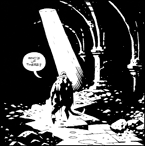 Mignola:
Well, itís hard to put my finger on it. They called me because they
were sort of doing the film in my style. They brought me in to design
characters, but I was kind of a general consultant to the look of the
film. My primary focus was designing the city of Atlantis; designing
location kind of stuff. I did some character design stuff, but itís
very curious. Theyíd already designed a lot of stuff to look like I
had designed it. So a lot of things that people would say, ďoh,
thereís a Mike Mignola character,Ē I actually had almost nothing to
do with. It was a very bizarre experience. I also made some comments on
story. There were a couple of scenes that kind of came out of
conversations I had. The weirdest thing was to sit there at lunch and
say ďwhat about this, what about this, what about this?Ē, which only
takes ten seconds to do, and then Iíd come back a couple months later
and, boom, that sceneís in the movie. Mignola:
Well, itís hard to put my finger on it. They called me because they
were sort of doing the film in my style. They brought me in to design
characters, but I was kind of a general consultant to the look of the
film. My primary focus was designing the city of Atlantis; designing
location kind of stuff. I did some character design stuff, but itís
very curious. Theyíd already designed a lot of stuff to look like I
had designed it. So a lot of things that people would say, ďoh,
thereís a Mike Mignola character,Ē I actually had almost nothing to
do with. It was a very bizarre experience. I also made some comments on
story. There were a couple of scenes that kind of came out of
conversations I had. The weirdest thing was to sit there at lunch and
say ďwhat about this, what about this, what about this?Ē, which only
takes ten seconds to do, and then Iíd come back a couple months later
and, boom, that sceneís in the movie.
Westfield:
Was it an enjoyable experience?
Mignola:
Yeah. It was very interesting. I didnít work on it that much. I would
go down to Disney for, at most, maybe three days at a stretch and then I
did some design work at home. But for the most part, I would go back
down and check in and put my two cents in here and there. They were
really doing a very thorough job of adapting my style without needing me
to be there. When I got there, they had already done these big panels
where they had enlarged panels from various comics and there were notes
all over them explaining how to do what I do and why I do what I do. I
looked at them and said ďreally? Thatís what I do? I had no idea.Ē
[laughter] So that was pretty bizarre. It was weird to walk into Disney
and see Hellboy everyplace.
Westfield:
Have you seen the finished film?
Mignola:
Iíve seen it maybe half finished.
Westfield:
Do you like what youíve see?
Mignola:
Yeah. Again, I have no objectivity with it. I know what isnít there. I
know the scenes that were discussed that were not used for one reason or
another. So I canít look at the movie objectively because I know too
much about it. But itís pretty impressive, letís put it that way.
Westfield:
Do you have any upcoming projects youíd like to mention?
Mignola:
Iíve learned that it looks like weíve been OKíd to do a second
Hellboy novel. Again, Chris Golden will write and I will illustrate, so
Iím excited about that. I just finished working on the movie Blade
2. After this Hellboy mini-series, Iím going to be doing a
one-shot black and white comic that will be published by someone other
that Dark Horse. It will be a small, little thing that Iím really
excited about. A brand-new, very bizarre, little project.
Westfield:
Any closing comments?
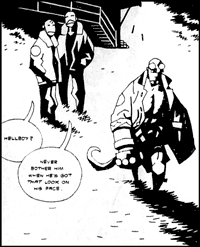 Mignola:
I hope people buy this mini-series. Everything thatís been done with
Hellboy, all the big Hellboy stories, pretty much comes to a conclusion
here. So I view this mini-series as the end of the first cycle of
Hellboy stories. In that respect, itís actually kind of a big one. Mignola:
I hope people buy this mini-series. Everything thatís been done with
Hellboy, all the big Hellboy stories, pretty much comes to a conclusion
here. So I view this mini-series as the end of the first cycle of
Hellboy stories. In that respect, itís actually kind of a big one.
|